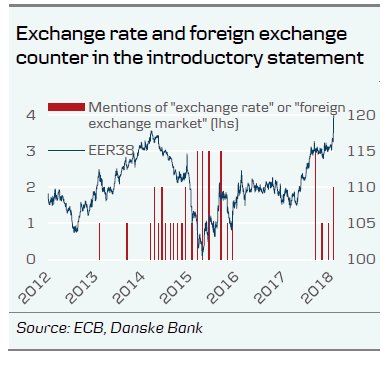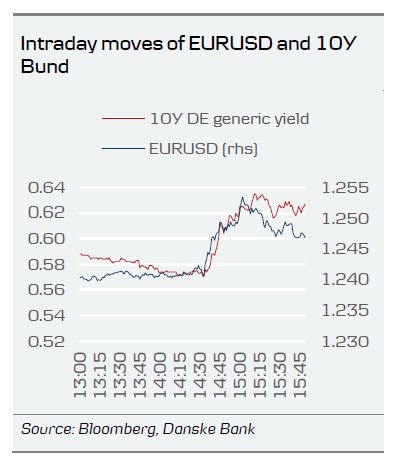- Overall, President Draghi struck a dismissive tone on changes to language indicating that monetary policy normalisation is only in the very early stage with changes to forward guidance yet to be discussed. Sequencing is set in stone.
- Growth is still strong and inflation still subdued.
- The exchange rate was mentioned twice in the introductory statement as a source of uncertainty that requires monitoring, a sentence that has not been used since September 2017. In particular, external drivers were used as concerns.
In line with our expectation, the ECB left its policy measures and forward guidance unchanged, keeping the QE programme open-ended (see also Preview). The ECB reiterated that policy rates would remain at current levels for an extended period and well past the horizon of asset purchases. Today’s press conference confirmed our view that a change to the asymmetric communication on the purchase programme will come at the 8 March meeting.
The big joker in today’s meeting was the exchange rate. The exchange rate made it back into the introductory statement as a source of uncertainty that requires monitoring, a sentence that hasn’t been used since September 2017 when the trade-weighted 38 had risen about 5% in the months leading to the press conference. The current trade-weighted 38 is only up 1% since mid-November.
Draghi was asked about the apparent discord between the December meeting and the accounts, and while he said that there was no misalignment and GC members were surprised about the market reaction, we view the accounts and the hawkish messages from early January from e.g. Weidmann and Hansson, as a result of an increasingly split GC. Going forward, that will be a balancing act between a gradual change in the forward guidance and catering for the hawks.
Further, to this end, Draghi confirmed that there is only a very small chance of a hike this year, which confirms our view of a very gradual normalisation and sequencing being set in stone. We still expect a rate hike in Q2 19.
During the introductory statement and the Q&A session Draghi/ECB acknowledged that market inflation expectations have risen and there are some signs that wage growth is picking up. That said, Draghi is still very dovish on the inflation outlook and stresses that the ECB has yet to grow confident that it’s self-sustaining.
Towards the end of the press conference, Draghi again stressed that rising headline inflation due to i.e. higher oil prices alone is not enough to make them confident on the inflation outlook. ECB wants to see rising underlying inflation pressures which are self-sustained

Exchange rate:
The exchange rate was mentioned twice in the introductory statement as a source of uncertainty that requires monitoring, a sentence that has not been used since September 2017. Draghi also sent a very clear critique towards the US regarding its weak US dollar (USD) policy. However, the euro (EUR) still rose sharply during the press conference particularly versus the USD and the Japanese yen. This illustrates that the apparent shift in the US Treasury’s dollar stance is dominating any Draghi worries. In our view, the US’s weak USD policy together with broad basic balance of payment (BBoP) support for the EUR will continue to push EUR/USD higher. (For more details see Strategy – Push for a weaker USD supported by flows, 25 January 2018).
Fixed income:
The impact on the fixed income markets from the press conference was initially modestly bullish with the long end performing as the ECB is no hurry to taper. However, given the strong focus on the positive growth outlook as well as inflation “hovering” around current levels bond yields went higher. So ECB/Draghi are sending a positive signal on growth for the Eurozone economy, but also that they are in no hurry to change the forward guidance. Hence, they are trying to move slowly, which is sending yields higher, with the 5Y and 10Y segment on the yield curve bearing the brunt of the rise in rates combined with a stronger EUR versus the USD. Hence, we see room for more flattening between 10Y and 30Y.
The spread between the peripheral markets and core EU tightened initially, but later during the press conference the sentiment changed, sending spreads modestly wider perhaps driven by the comments that the ECB does not favour any country in the QE, and the market should not focus on monthly deviations, but more on the gross amounts relative to the capital key. Hence, he is downplaying the QE deviations we have seen so far. We think the market is overacting to the comments. Hence, we keep our longs in Portugal and Ireland and add a long position in Spain given the growth outlook and that the ECB is no hurry to tighten monetary policy. In all three markets we buy the new 10Y benchmarks versus core EU.













